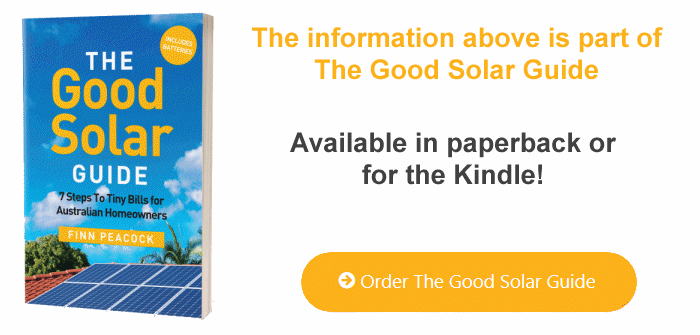Fundamental 2: Solar rebate versus solar feed-in tariff
← Power Vs. Energy | The Good Solar Guide Contents | Solar Power System Types →
When it comes to the solar rebate and your solar feed-in tariff, in my experience, most people outside the solar industry think these two things are one and the same. In fact, apart from mixing up kW and kWh, it’s the biggest misunderstanding I come across when talking to people who are considering going solar.
The classic line I hear is: ‘The rebate has gone way down to virtually nothing! Solar’s not worth it – the opportunity has passed!’
This belief couldn’t be more wrong. To help you understand why, let me explain exactly what these two terms refer to.
The solar rebate4
If you buy a solar system today, it is subsidised by a government administered scheme (small-scale technology certificates, known as STCs). At the time of writing (early 2018), this scheme will save you about $600 per kW of solar installed. That’s a saving of around $3,000 for a typical 5 kW system.
Online resource: See the current maximum solar rebate value where you live: solarquotes.com.au/rebate
The rebate is applied at the point of sale (meaning any advertised prices you see almost certainly have the rebate already applied).
Under the current legislation, this rebate dropped by one-fifteenth in January 2017, one-fourteenth in January 2018, and it will drop every January until it reaches zero in 2031.
The solar rebate subsidises the upfront cost of installing a solar power system and is not means-tested in any way. The only criteria for claiming it are:
- Your system is less than 100 kW in size.
- You get it installed and designed by a Clean Energy Council-accredited professional.
- You use solar panels and inverters that are approved for use in Australia by the Clean Energy Council.
- You are not replacing existing panels in an existing system.
Interestingly, these rules have all but removed the concept of DIY solar power in Australia. If you are not accredited and do the installation yourself (though, legally, you’d need a sparky for the 230 V parts), you can’t claim the rebate. The rebate should easily cover the cost of installation, though, making it cheaper to get the professionals in.
The best things about the solar rebate are that everyone is eligible, you can claim it as many times as you want (up to 100 kW per system) and you don’t have to do anything to claim it except engage a good installer who will process all the paperwork for you.
The feed-in tariff
The feed-in tariff is something completely different from the rebate, so don’t get them mixed up!
When your rooftop solar generates more electricity than your home is using at any point in time, it isn’t wasted – instead, it’s sent into the grid for other people to use. A feed-in tariff is the payment you receive for selling electricity to the grid.
Although feed-in tariffs are still available (and should always be), they are worth much less than they used to be. Hence the mistaken belief that the rebate has dropped. The rebate is very much alive and kicking, it’s the feed-in tariff that’s dropped.
Feed-in tariffs were initially high to encourage the uptake of solar, back when solar cost three to four times the price it is now. It worked. The solar industry is well established and prices for Australian solar systems are the lowest in the world, thanks to high-volume and efficient installers.
Unfortunately, outside the Northern Territory and some parts of regional Western Australia, feed-in tariffs for new rooftop solar are low compared to the retail price of electricity.
The quickest and easiest way to find the solar feed-in tariffs currently offered by electricity retailers in your area is to go to my online electricity retailer comparison page and enter your postcode.
Online resource: Compare feed-in tariffs in your area: solarquotes.com.au/energy
This tool compares most of the electricity retailers in your area and you may well find you can get a much more generous feed-in tariff by shopping around. Look at typical feed-in tariffs and consumption tariffs in your postcode and write them down either here or in the downloadable worksheet that covers all the exercises in the book at solarquotes.com.au/worksheet. We’ll use them when working out the payback of solar.
Typical feed-in tariff in my postcode _____c per kWh
Typical usage tariff in my postcode _____c per kWh
The important thing to understand is that this feed-in tariff is not the same as the rebate. Feed-in tariffs have come down from their highs of five years ago, but the rebate is still generous.
4The government doesn’t want us to call it the solar rebate. They want us to call it the solar financial incentive. In the real world almost everyone calls it the solar rebate, so I will too.
← Power Vs. Energy | The Good Solar Guide Contents | Solar Power System Types →
Questions or feedback about the content on this page? Contact me.
